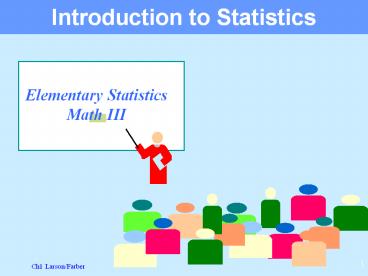Introduction to Statistics PowerPoint PPT Presentation
Title: Introduction to Statistics
1
Introduction to Statistics
Elementary Statistics Math III
2
- Statistics is the science of collecting,
organizing, analyzing, and interpreting data in
order to make decisions.
3
Important Terms
- Population
The collection of all responses, measurements,
or counts that are of interest.
- Sample
A portion or subset of the population.
4
Important Terms
- Parameter
A number that describes a population
characteristic.
Average gross income of all people in the
United States in 2002.
- Statistic
A number that describes a sample characteristic.
2002 gross income of people from a sample of
three states.
5
Random Sample Each member of the population
has an equal chance of being selected. Simple
Random Sample All samples of the same size are
equally likely.
- Assign a number to each member of the population.
- Random numbers can be generated by a random
- number table, software program or a calculator.
- Data from members of the population that
correspond to these numbers become members of
the sample.
6
Stratified Random Samples
- Divide the population into groups (strata)
and select a random sample from each group.
Strata could be age groups, genders or levels of
education, for example.
Sample
7
Cluster Samples
Divide the population into individual units or
groups and randomly select one or more units. The
sample consists of all members from selected
unit(s).
Cluster Sample
8
Systematic Samples
Choose a starting value at random. Then choose
sample members at regular intervals.
x x x x x x x x x x x x x x x x x x x x x x x x x
x x x x x x x x x x x x x x x x x x x x x x x x x
x x x x x x x x x x x x x x x x x x x x x x x x x
x x x x x x x x x x x x x x x x x x x x x x x x x
x x x x x
We say we choose every kth member. In this
example, k 5. Every 5th member of the
population is selected.
9
Other Samples
Convenience Sample Choose readily available
members of the population for your sample.
10
Data Collection
- Experiment
Apply a treatment to a part of the group.
- Simulation
Use a mathematical model (often with a computer)
to reproduce condition.
- Census
A count or measure of the entire population
- Sampling
A count or measure of part of the population.
11
- Qualitative data-
- Deals with descriptions.
- Data can be observed but not measured.
- Colors, textures, smells, tastes, appearance,
beauty, etc. - Qualitative ? Quality
- Quantitative data-
- Deals with numbers.
- Data which can be measured.
- Length, height, area, volume, weight, speed,
time, temperature, humidity, sound levels, cost,
members, ages, etc. - Quantitative ? Quantity

